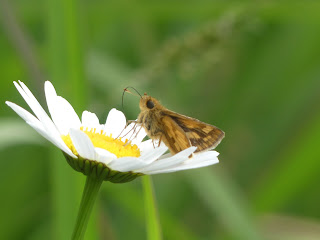Common Jewelweed
Here's another dampness-loving native wildflower: Common Jewelweed. Or at least I think it is; the Pale Jewelweed is pretty similar:
- Common Jewelweed is supposed to have orange, clearly spotted flowers while the Pale Jewelweed is supposed to be a pale yellow with more subtle spots. My interpretation of my wildflower is that it's vibrant yellow with a hint of orange, so I think this is supportive of it being a Common Jewelweed.
- The leaves of the Pale Jewelweed are supposed to be nearly as wide as they are long (though some pictures seem to suggest otherwise), so I think the leaves are more supportive of the Common Jewelweed too.
- It sounds like the Pale Jewelweed is a somewhat larger plant with somewhat smaller flowers. It's hard to judge size by this picture, so I'd consider this to be inconclusive.
- I read afterwards that they both have a little "spur" underneath the flowerhead, and that in the Common Jewelweed the spur is bent more so that the end of it is parallel to the flower itself. Unfortunately I don't have a picture of that.
- Habitat doesn't hold much of a clue either, since these 2 species will sometimes live side by side. The Common Jewelweed is considered to be, as its name suggests, more common.
So I'm tentatively going to consider this to be the Common Jewelweed, though I suspect much of what I say applies to both species.
Native American and folk medicine claim the sap can alleviate skin rashes like from Poison Ivy or Stinging Nettle, though I don't think there's reliable evidence of this.
Our jewelweeds can reproduce in the normal way: pollinators carrying pollen from one plant to the next, cross-pollinating the downstream one. But they can also produce self-pollinating flowers (which are not the showy ones I photographed) through a process called cleistogamy. In addition to our jewelweeds, some legumes and violets can also reproduce this way.
Why are they called jewelweeds?
- They're supposed to look silvery when underwater. (I'm not sure I like this theory since they're not normally underwater.)
- More promising is that rain or dew drops on the leaves can also look silvery.
- Finally, their seeds are "robin egg blue", and probably look a bit like small jade stones.
They're also called touch-me-nots, and for a clearer reason. When they're ready to distribute seeds, touching them triggers explosive dehiscence, where the jewelweed can propel its seeds 4-6 feet away.
 |
| July 30, 2021 at Negri Nepote Native Grassland Preserve Photo 149014035, (c) jpviolette, some rights reserved (CC BY-NC) |



Comments
Post a Comment